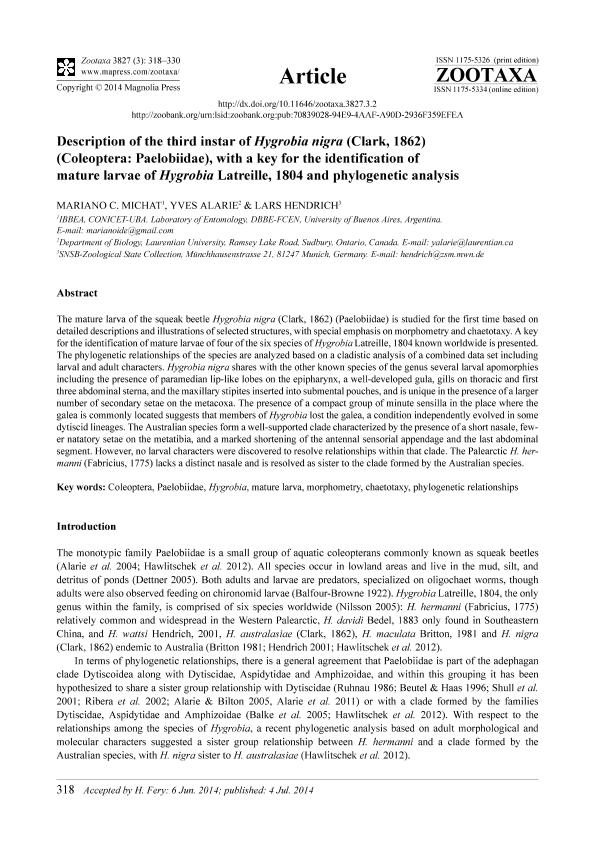Mostrar el registro sencillo del ítem
dc.contributor.author
Michat, Mariano Cruz

dc.contributor.author
Alarie, Yves

dc.contributor.author
Hendrich, Lars
dc.date.available
2017-07-04T20:13:30Z
dc.date.issued
2014-07
dc.identifier.citation
Michat, Mariano Cruz; Alarie, Yves; Hendrich, Lars; Description of the third instar of Hygrobia nigra (Clark, 1862) (Coleoptera: Paelobiidae), with a key for the identification of mature larvae of Hygrobia Latreille, 1804 and phylogenetic analysis; Magnolia Press; Zootaxa; 3827; 3; 7-2014; 318-330
dc.identifier.issn
1175-5326
dc.identifier.uri
http://hdl.handle.net/11336/19525
dc.description.abstract
The mature larva of the squeak beetle Hygrobia nigra (Clark, 1862) (Paelobiidae) is studied for the first time based on detailed descriptions and illustrations of selected structures, with special emphasis on morphometry and chaetotaxy. A key for the identification of mature larvae of four of the six species of Hygrobia Latreille, 1804 known worldwide is presented. The phylogenetic relationships of the species are analyzed based on a cladistic analysis of a combined data set including larval and adult characters. Hygrobia nigra shares with the other known species of the genus several larval apomorphies including the presence of paramedian lip-like lobes on the epipharynx, a well-developed gula, gills on thoracic and first three abdominal sterna, and the maxillary stipites inserted into submental pouches, and is unique in the presence of a larger number of secondary setae on the metacoxa. The presence of a compact group of minute sensilla in the place where the galea is commonly located suggests that members of Hygrobia lost the galea, a condition independently evolved in some dytiscid lineages. The Australian species form a well-supported clade characterized by the presence of a short nasale, fewer natatory setae on the metatibia, and a marked shortening of the antennal sensorial appendage and the last abdominal segment. However, no larval characters were discovered to resolve relationships within that clade. The Palearctic H. hermanni (Fabricius, 1775) lacks a distinct nasale and is resolved as sister to the clade formed by the Australian species.
dc.format
application/pdf
dc.language.iso
eng
dc.publisher
Magnolia Press

dc.rights
info:eu-repo/semantics/openAccess
dc.rights.uri
https://creativecommons.org/licenses/by-nc-sa/2.5/ar/
dc.subject
Coleoptera
dc.subject
Paelobiidae
dc.subject
Hygrobia
dc.subject
Mature Larva
dc.subject
Morphometry
dc.subject
Chaetotaxy
dc.subject
Phylogenetic Relationships
dc.subject.classification
Zoología, Ornitología, Entomología, Etología

dc.subject.classification
Ciencias Biológicas

dc.subject.classification
CIENCIAS NATURALES Y EXACTAS

dc.title
Description of the third instar of Hygrobia nigra (Clark, 1862) (Coleoptera: Paelobiidae), with a key for the identification of mature larvae of Hygrobia Latreille, 1804 and phylogenetic analysis
dc.type
info:eu-repo/semantics/article
dc.type
info:ar-repo/semantics/artículo
dc.type
info:eu-repo/semantics/publishedVersion
dc.date.updated
2017-07-04T15:32:12Z
dc.identifier.eissn
1175-5334
dc.journal.volume
3827
dc.journal.number
3
dc.journal.pagination
318-330
dc.journal.pais
Nueva Zelanda

dc.journal.ciudad
Auckland
dc.description.fil
Fil: Michat, Mariano Cruz. Consejo Nacional de Investigaciones Científicas y Técnicas. Oficina de Coordinación Administrativa Ciudad Universitaria. Instituto de Biodiversidad y Biología Experimental y Aplicada. Universidad de Buenos Aires. Facultad de Ciencias Exactas y Naturales. Instituto de Biodiversidad y Biología Experimental y Aplicada; Argentina
dc.description.fil
Fil: Alarie, Yves. Laurentian University; Canadá
dc.description.fil
Fil: Hendrich, Lars. Staatliche Naturwissenschaftliche Sammlungen Bayerns. ; Argentina
dc.journal.title
Zootaxa

dc.relation.alternativeid
info:eu-repo/semantics/altIdentifier/doi/http://dx.doi.org/10.11646/zootaxa.3827.3.2
dc.relation.alternativeid
info:eu-repo/semantics/altIdentifier/url/https://biotaxa.org/Zootaxa/article/view/zootaxa.3827.3.2
Archivos asociados
